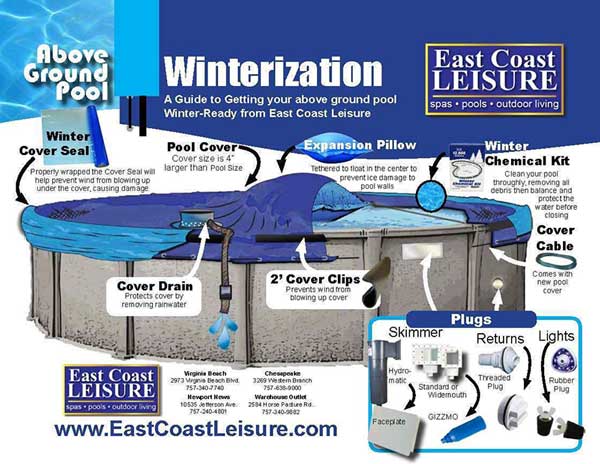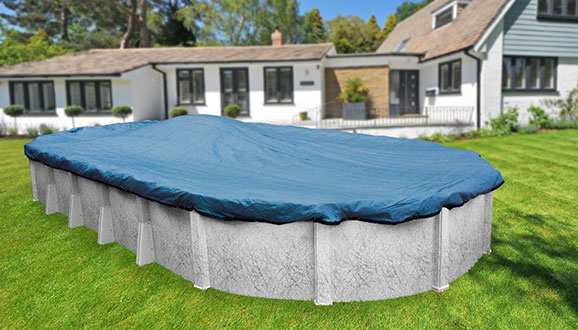CLOSING YOUR ABOVE GROUND POOL
If this is your first time Closing your pool and you are unfamiliar with the process, we hope these instructions will help guide you thru. If you have any further questions, feel free to contact us at 757-340-9882. East Coast Leisure Does not provide Above Ground Pool Closing Services.
These instructions are for a tarp style cover on a traditional steel, resin, or aluminum frame above ground or semi inground pool (Oasis style). If you have a soft sided pool It most likely came with a cover and instructions on how to open the pool. We recommend following those instructions.


- Flat head screw driver
- A large channel lock plier
- Two people capable of lifting at least 50 lbs.
When to close your pool.
In Hampton Roads the swimming season is between April and October, but many pool owners prefer to open their pools after the pollen falls and close it before the leaves begin to accumulate in the pool. It is recommended that you close the pool before temps fall below 32 degrees. Freeze damage can cause expensive repairs as well as down time in the spring when you are ready to use the pool.
Preparation
Start by removing all leaves and debris from the pool. Make sure that the pool water is properly balanced as you would when you open the pool. Brush the walls and vacuum the bottom if necessary. Clean and remove the skimmer basket and remove all of the jet return eyes,

Closing an aboveground pool step by step
- Add the appropriate pool closing chemicals for the water care system that you are using. We offer a both Simple Salt Winter Kits and traditional winter kits however some systems may suggest alternative options to complement their products. If you have any questions as to which winter product you should be using, please contact us.
- Turn the power of to the filter system, remove the return jet eye and plug with a threaded plug. If you have a thru the wall light, follow the winterizing instructions that came with the light. If you have a hydromatic pre filter skimmer, you will need to use a winterizing face plate to cover the skimmer. If you have a regular widemouth or traditional skimmer you can use either a face plate or an expansion plug to thread into the bottom of the skimmer. It is important that you identify and properly winterize your skimmer as a cold spell in the winter can freeze and crack it. Once both the skimmer and return are plugged you can begin to remove the equipment.
- Disconnect the filter, pump and other equipment by loosening the clamps that fasten the hose to the skimmer and return. If your pool is hard plumbed, it may require unthreading the unions at the same locations on the pool. Remove all drain plugs in the pump’s plastic housing and the filter to remove all sitting water. *Place these plugs somewhere where you will not forget them in the spring. We suggest putting them in the strainer pot of the pump.
- If you have a Cartridge or Simple Clean filter, remove the inner element and thoroughly wash and allow it to dry before placing it back into the housing. If it is possible, store the equipment in a dry location for the winter, otherwise do your best to protect it from extreme exposure to the elements.
- Before putting the cover on, inflate your expansion pillow ¾ of the way full. Use a string to tie off the pillow in all four corners to prevent movement while you pull the cover over the pool. The expansion pillow is meant to protect the wall from surface ice. It allows the ice to expand inward potentially damaging the pillow rather than the liner.
- If you are opening the pool cover for the first time. Make sure it is the correct size. Cover boxes usually include the pool size and the cover size. Generally, the cover size is 3-4’ larger than the pool size (ex: pool size 24 round, cover size 28 round) If the cover is not correct return, it to the store for an exchange before opening the box. If it is correct, open the box, unfold the cover and begin to walk it around the pool like you are making a bed. Avoid allowing water on top of the cover as best as you cane while covering the pool. Included with the cover is a winch and cable once the cover is resting evenly around the pool, begin to weave the cable thru the grommets (brass holes). Once you have made it all the way around, pull the cable tight and slide both ends of the cable thru the winch until it is tight, then twist the crank until the cable is tight.
- Once the cover is on, we recommend securing it with two layers of protection from wind and weather. The first layer is the cover clip which fastens the cover to the top rail. You should use one 2’ clip per top rail. The second step is winter cover seal. This is a UV protected plastic wrap that is wrapped around the perimeter of the pool.
Once all steps are complete, walk around the pool and make sure everything looks secure. Pick up any equipment, and store in a dry location.
Use a cover drain to remove water from the cover as it accumulates thru the winter
COMMON Q&A ABOUT WINTERIZING.
Do I have a leak in my liner, It looks like my pool is losing water?
You may have a liner leak but more likely you are losing water because rainwater on the cover is pushing the pool water out. Similar to putting ice in a cup, rainwater is raising the level of the water underneath to a point where it pushes water out. Then when you drain the rainwater pool water level will be lower.
Why did my expansion pillow pop?
The expansion pillow is meant to absorb ice to protect it from damaging the liner. So if it popped it is likely because it was doing what it was meant to do.
Does ECL close Aboveground pools?
ECL only closes pools with safety style covers that fasten to a deck or concrete. The pool must be properly balanced and are free of debris at the time of the closing. We have experienced that most customers find that when they see the simplicity of closing an aboveground pool, they feel that they could have done it themselves.
We hope this will help you thru the process of closing your pool. We also offer pool closing classes every year. They usually start the third Monday of September and continue on for the next 3 weeks. Contact us for details.